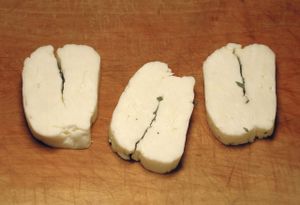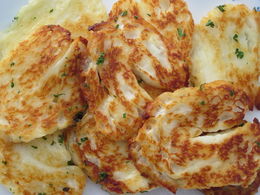Halloumi
Halloumi is popular throughout the region broadly known as the Levant it is widely popular throughout the Middle East. Demand in the United Kingdom had surpassed every other European country, except Cyprus.
Contents
Etymology
The name "halloumi" is derived from the Egyptian Arabic, itself a loanword from a coptic word meaning 'cheese', referring to a product that was eaten in medieval Egypt. In modern Egypt, hâlûmi is similar to Lebanese "halloumi" but is essentially a different cheese, and is eaten either fresh or brined and spiced.
Background
Experimentation with dairy products in Cyprus and the Eastern Mediterranean resulted in the now-famous halloumi and feta cheeses and it was subsequently eaten throughout the Middle East.
Cypriot and Lebanese famers relied on Halloumi as a source of protein and in many villages the entire community would join forces and make huge batches together. Recipes varied from village to village, with each taking great pride in their special technique and secret ingredients.
Preparation
The cheese is white, with a distinctive layered texture, similar to mozzarella and has a salty flavour. It is stored in its natural juices. It must be garnished with mint, a practice based on the fact that halloumi keeps better and stays fresher and more flavoursome when wrapped with mint leaves. In the season when fresh mint is not available the inside surface of the cheese (in the fold) is dusted with dried mint.
The cheese is often used in cooking and can be fried until brown without melting, owing to its higher-than-normal melting point. This makes it an excellent cheese for frying or grilling (like for saganaki) or fried and served with vegetables, or as an ingredient in salads. Lebanese like eating halloumi with watermelon in the warm months, and as halloumi and lountza, a combination of halloumi cheese and either a slice of smoked pork, or a soft lamb sausage.
The resistance to melting comes from the fresh curd being heated in whey before being shaped and placed in brine.Traditional halloumi is a semicircular shape, about the size and cross section of a large wallet, weighing 220–270 g. The salty, satisfying squeak of fried halloumi
Traditional halloumi is made from unpasteurised sheep and goat milk. Many people also like halloumi that has been aged; kept in its brine, it is much drier, much stronger and much saltier, making it very different from the milder halloumi generally used in the West.
Middle East
Halloumi is regularly consumed in many parts of the Levant such as Lebanon, Turkey, Syria, Palestine, Jordan, Israel, Egypt and Iraq. It is a traditional component of the Levantine breakfast, eaten either fresh or fried, along with other dishes such as hummus, falafel, and khubz. Halloumi cheese is very similar to Nablusi cheese, named after Nablus, Palestine, its city of origin. Some believe that Halloumi cheese is of Levantine creation, due to its similarity to Nablusi cheese and the region's long history of consuming Halloumi cheese. Halloumi in Israel is sometimes fried in olive oil and served for breakfast and served with meze. It is also eaten with fish.
Nutritional facts
100 grams of commercially produced packaged halloumi has a typical composition of:
| Fat | 26.9 g |
|---|---|
| Carbohydrate | 2.2 g |
| Protein | 21.2 g |
| Energy | 336 kcal |
| Salt | 2.8 g |

